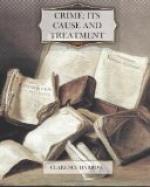During the last thirty years, psychological laboratories, aided by physiology, through oft-repeated experiments conducted with newly-invented weighing and measuring instruments of marvelous accuracy, have put us in possession of an array of facts unknown to students of earlier periods, who sought the “why and the how” of man’s erratic actions as a social animal. It is constantly being demonstrated that under given conditions, moved by appropriate stimuli, the human animal inevitably and surely reacts the same as does inorganic matter. If we understand “intelligence” to be the “capacity to respond to new conditions,” we can measurably see and at least partly understand the constant inter-play of heredity and environment. Between these there is no antagonism. The sum of life experiences consists solely in the adjustments required to enable the sentient organism—man or beast—to live.
How readily a “throw-back” to earlier and cruder life may be brought about under favorable conditions, is shown by the methods and virulence of combat during the vicious massacre in the war just ended. Can the conclusion be evaded that individually and collectively we constantly teeter on the brink of a precipice? If we fall it spells crime or misfortune, or both.
Wherever civilization exists on the private property basis as its main bulwark, we find crime as an inseparable result. Man, by virtue of his organic nature, is a predatory animal. This does not mean that he is a vicious animal. It simply means that man, in common with the eagle and the wolf, acts in accordance with the all-impelling urge and fundamental instincts of his organic structure. In any conflict between newer and nobler sentiments and the emotions which function through the primeval instincts, he is shackled to the bed-rock master instincts in such manner that they usually win. This is conclusively shown by the history of the race.
If this is true, we should expect to find the master hunger specially active through the many chances presented for exploitation after the fall of feudalism—beginning, let us assume, with the invention of power machinery—the “Age of Steam”. It is apparent that from that time to our own day, man’s acquisitive tendency has so expanded, that if we were capable of an unbiased opinion it might be said to be a form of megalomania gripping the entire white race, where highly-developed commerce and industry are found in their most vigorous forms.
If our theory is correct, we should expect to find the most energetic and enterprising nations showing a greater ratio of property crimes than the invalid and feeble nations. This would more certainly be true where political constitutions by letter and spirit encourage and promote individual development, mental and industrial. When this condition exists with abundant natural resources, such as often may be found in what we term a new country, it furnishes the chance for the most vigorous functioning of whatsoever may be the dominant qualities inherent in the tendencies and aspirations of a people. The United States of America, among the nations, meets these conditions, and we find here the highest ratio of property crimes per capita. This holds as to all such crimes, both minor and major, which are far in excess of those of any other nation, as shown by statistics.




